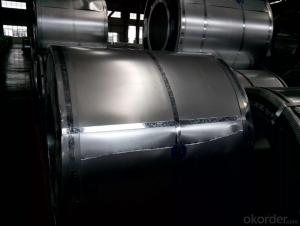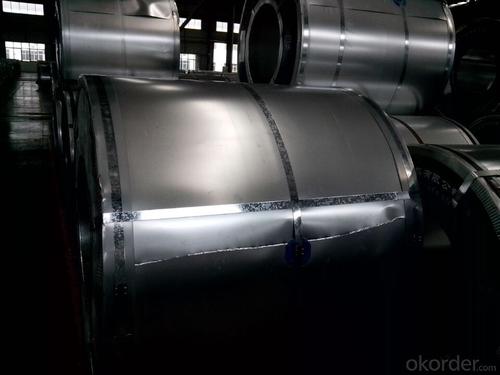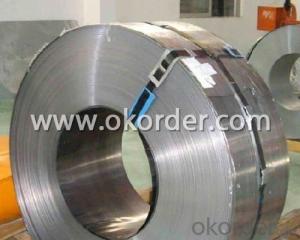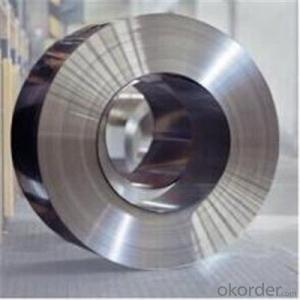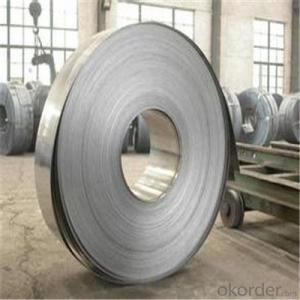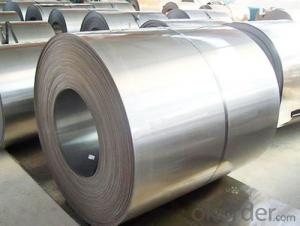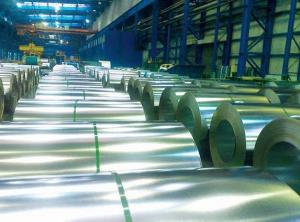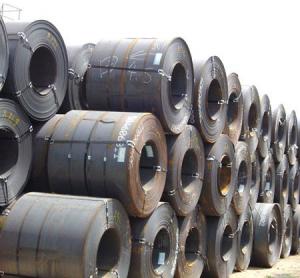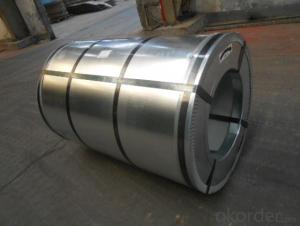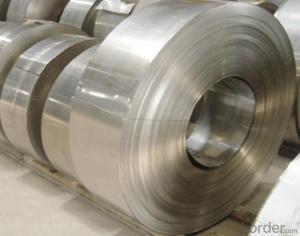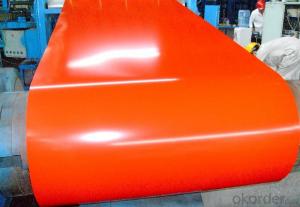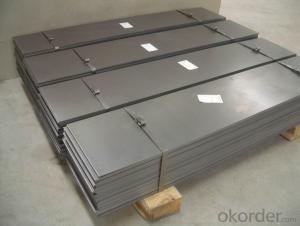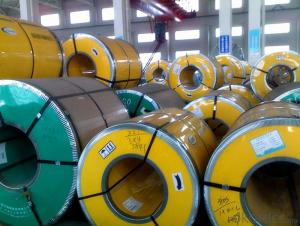Hot Dipped Galvanized Steel Strip Coil
- Loading Port:
- China Main Port
- Payment Terms:
- TT OR LC
- Min Order Qty:
- -
- Supply Capability:
- -
OKorder Service Pledge
Quality Product, Order Online Tracking, Timely Delivery
OKorder Financial Service
Credit Rating, Credit Services, Credit Purchasing
You Might Also Like
Hot Dip Galvanized Steel Strip Coil
Steel Grade & Standard:JIS G3302 SGHC
Zinc Coating Mass:Z14
Spangle:Regular Spangle
Surface Treatment:CHROMATED & UNOILED
Thickness:3.7mm
Width:620mm
Coil ID:610mm
Coil Weight:4MTS MIN
- Q: How do steel strips handle exposure to chemicals?
- Steel strips generally have good resistance to exposure to chemicals. However, the level of resistance can vary depending on the type of chemical and the specific alloy composition of the steel. Stainless steel strips, for example, are highly resistant to corrosion from many chemicals due to their high chromium content. It is always recommended to consult the chemical compatibility charts or seek expert advice to ensure the appropriate steel strip is chosen for specific chemical environments.
- Q: How are steel strips tested for mechanical properties?
- Steel strips are tested for mechanical properties through various methods such as tensile testing, impact testing, hardness testing, and bend testing. These tests involve subjecting the steel strips to controlled forces or impacts to measure properties like strength, ductility, toughness, and hardness. This helps in determining the performance of the steel strips under different conditions and ensures that they meet the required mechanical specifications for their intended applications.
- Q: Can steel strips be used in the production of bicycle frames?
- Yes, steel strips can be used in the production of bicycle frames. Steel is a commonly used material in the manufacturing of bicycle frames due to its strength, durability, and affordability. Steel strips can be shaped and welded together to create the main structure of the frame, providing a solid and rigid foundation. The use of steel strips allows for flexibility in design and customization, as different shapes and sizes can be easily achieved. Additionally, steel frames offer excellent ride quality, as they absorb vibrations and provide a smooth and comfortable riding experience. Overall, steel strips are an ideal choice for bicycle frame production, offering a combination of strength, durability, and versatility.
- Q: Can steel strips be used in the production of signage?
- Yes, steel strips can be used in the production of signage. They provide durability, strength, and a professional appearance, making them a popular choice for outdoor and industrial signage applications.
- Q: How are steel strips used in the production of automotive suspension components?
- Steel strips are used in the production of automotive suspension components as they provide strength, durability, and flexibility. These strips are commonly used to manufacture coil springs and leaf springs, which are crucial for absorbing shocks and providing stability and control to the vehicle's suspension system.
- Q: Are steel strips used in the production of shipping containers?
- Yes, steel strips are commonly used in the production of shipping containers. Steel is known for its strength and durability, making it an ideal material for constructing containers that can withstand the rigors of transportation and protect the goods inside. Steel strips are often used to form the structural framework of the container, providing stability and support. Additionally, steel strips are also used for reinforcing the corners and edges of the container, as these areas are more susceptible to damage. Overall, the use of steel strips in the production of shipping containers ensures that the containers are strong, secure, and capable of withstanding the demands of the shipping industry.
- Q: How are steel strips used in the production of jewelry?
- Steel strips are used in the production of jewelry primarily for their strength and durability. They serve as a base material for certain types of jewelry, such as bangle bracelets and rings. Steel strips provide a sturdy foundation that can withstand daily wear and tear, ensuring that the jewelry piece remains intact and maintains its shape over time. In addition to their strength, steel strips also offer versatility in design. They can be easily shaped and manipulated into various forms, allowing jewelry makers to create unique and intricate designs. Steel strips can be bent, twisted, and formed into different shapes, enabling the production of complex patterns and textures in jewelry. Steel strips are also commonly used in jewelry making for their cost-effectiveness. Compared to precious metals like gold or silver, steel is a more affordable option. This makes it an ideal choice for producing fashion jewelry or pieces that require a larger quantity of material, such as chains or statement necklaces. By using steel strips, jewelry artisans can offer more affordable options to consumers without compromising on quality or aesthetics. Furthermore, steel strips are often coated or plated with other materials to enhance their appearance. They can be plated with precious metals like gold or silver, giving the jewelry a luxurious look at a fraction of the cost. The plating process also adds a layer of protection, preventing the steel from tarnishing or corroding over time. In summary, steel strips are used in the production of jewelry for their strength, durability, versatility, and cost-effectiveness. They provide a solid foundation for various types of jewelry and can be shaped into intricate designs. Additionally, steel strips can be coated or plated with other materials to enhance their appearance and protect them from damage.
- Q: How are steel strips processed for engraving?
- Steel strips are processed for engraving through a series of steps that involve preparation, engraving, and finishing. Firstly, the steel strips are cleaned and degreased to remove any dirt or oil, ensuring a smooth surface for engraving. This is typically done using solvents or chemical cleaners. Once the strips are clean, they are usually coated with a layer of photoresist material. This photoresist acts as a protective barrier against the engraving process. The steel strips are then exposed to UV light through a pattern or template, which hardens the photoresist in specific areas. Next, the strips undergo the actual engraving process. This can be done using different techniques, such as chemical etching or laser engraving. In chemical etching, the steel strips are immersed in an etching solution that selectively removes the unprotected areas of the photoresist, exposing the steel underneath. On the other hand, laser engraving uses a focused laser beam to directly remove the photoresist and etch the steel. After the engraving is complete, the remaining photoresist is typically stripped off using a chemical solution or mechanical methods. This reveals the engraved design on the steel strips. Depending on the desired finish, the strips may undergo further treatments like polishing or coating to enhance the appearance and durability of the engraving. Overall, the process of engraving steel strips involves cleaning, coating with photoresist, exposing to UV light, engraving, removing the photoresist, and applying finishing touches. This ensures precise and detailed engravings on the steel strips, making them suitable for various applications such as decorative items, industrial marking, or identification tags.
- Q: How are steel strips used in the production of kitchen utensils?
- Kitchen utensils utilize steel strips in various ways during production. Firstly, these strips serve as the primary material for the utensils. Steel is renowned for its robustness and endurance, making it an exceptional choice for utensils that must endure frequent usage and exposure to heat and moisture. The strips undergo cutting, shaping, and forming processes to create diverse utensil shapes, such as spoons, forks, and spatulas. Furthermore, steel strips find application in manufacturing the handles of kitchen utensils. These strips are bent, molded, and affixed to the main body of the utensil to provide users with a comfortable and sturdy grip. To enhance grip and prevent slipping, the steel handles are often coated with materials like rubber or plastic. Additionally, steel strips are utilized for producing cutting utensils like knives. These strips are sharpened to form the blade, which is then attached to a handle. The steel used for knife blades undergoes hardening and tempering processes to ensure sharpness and longevity. To sum up, steel strips play a vital role in the production of kitchen utensils. They provide the necessary strength and durability for utensils to withstand daily use and can be shaped into various designs. Whether used as the base material, for handles, or for blades, steel strips are an indispensable component in the manufacturing process of kitchen utensils.
- Q: How are steel strips processed for soldering?
- Steel strips are typically processed for soldering by first cleaning and degreasing the surface to remove any dirt, oils, or contaminants. This is followed by applying a flux to the steel strip, which helps to remove any oxidation and promotes better solder adhesion. The flux is usually applied through a dipping or spraying process. Once the flux is applied, the steel strip is heated to the appropriate temperature for soldering, and the solder is then applied to the surface, melting and bonding with the steel.
Send your message to us
Hot Dipped Galvanized Steel Strip Coil
- Loading Port:
- China Main Port
- Payment Terms:
- TT OR LC
- Min Order Qty:
- -
- Supply Capability:
- -
OKorder Service Pledge
Quality Product, Order Online Tracking, Timely Delivery
OKorder Financial Service
Credit Rating, Credit Services, Credit Purchasing
Similar products
Hot products
Hot Searches
Related keywords
